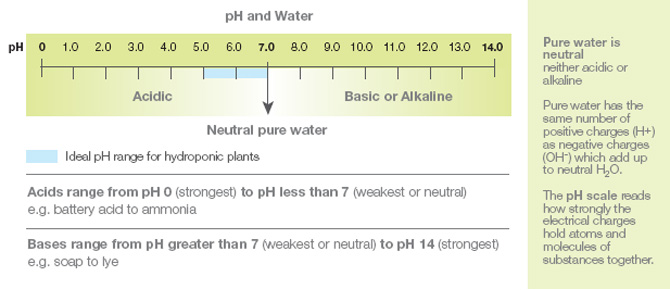
 |
|
Hydroponics - Indoor HorticultureHydroponics - Indoor Horticulture represents an educational, in-depth,
up-to-date,
indoor horticultural growers guide that covers all principles of indoor Hydroponics - Indoor Horticulture examines, explores, dissects and
presents a fully comprehensive step by step growers guide, relating
to all and every aspect of indoor hydroponic horticulture, with complete
chapters on plant biology, propagation, hydroponic systems, nutrients,
oxygen, carbon dioxide enrichment, pH, biological pest control, fungi/disease,
cuttings/clones, pruning/training, breeding, harvesting, equipment,
grow rooms, a full history of hydroponics, and more. |
| (Below follows a one page sample taken from the book) |

pH and WaterAfter adding your nutrient to the solution and adjusting it to the right level, it’s time to test for your pH level. If your meter reads high you need to add pH down to it, and if too low then you will need pH up. Both pH down and pH up are extremely strong and very aggressive, so handle with care and only administer a tiny amount at a time to your solution, mix your solution well and allow the pH up or down to dissolve, then take another reading using your pH meter. If you find the value is still too high or too low then re-administer another tiny amount of your pH up or down.If you find that you administer too much pH up or down then it is best practice to throw your solution away and start again, i.e. if you are living in a hard water area and you are adding pH down to your solution, if you add too much pH down into your solution then you are best advised to throw it away and start again rather than trying to get the level back up with pH up. This is due to the fact that pH up and down are aggressive and when administered to the solution they will attack your nutrient. Adding up to counteract the down is obviously bad practice as you have administered too much in the first place, then you are administering more which does your nutrients, and for that matter, your plants no favours. Same applies if you are in a soft water area and you are administering pH up to your solution and again you administer too much pH up, then you are again advised to throw that solution away rather than to try and balance it out with pH down. Less is always best in the world of hydroponics. Once your solution has been buffered with the right level of nutrient and balanced at the right pH level, it is now time to soak your rockwool blocks. |
Some growers allow the blocks
to soak overnight, and in practice is the right procedure when using tap
water as this allow the chlorine to rise to the top of the water, so the
rockwool takes up less chlorine from the water. Once you have completed the above, then you should either give the cube a light squeeze reducing the volume of water held in the block by approximately 10%, or by flicking a little water out by making a quick downwards motion with your hand whilst holding the block, again only looking to take the excess water from the cube by approximately 10%. This is done to make sure that when the seeds are planted that the rockwool has adequate air inside the block to support life so that the seed can breathe. Rockwool, by its own nature, holds water like a sponge. Therefore, if you plant a seed into rockwool that is completely saturated, there’s a good chance the seed will germinate, then the seed will promptly suffocate and drown due to the excessive amount of water and the sad realisation that it has no air to breathe. The result will be a mushy dead seed/seedling. |
|
 |